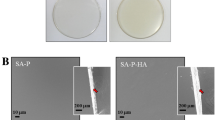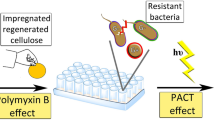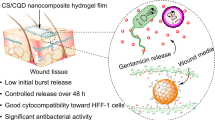Abstract
Antimicrobial photodynamic therapy (APDT) is a promising approach for treatment of wounds infected with antibiotic-resistant bacteria. In this approach, delivery of appropriate concentration of photosensitizer (PS) at the infected site is a critical step; it is therefore essential that PS need to be administered at the infected site in a suitable formulation. Here, we report preparation of PS-embedded composite biopolymer films and their photobactericidal properties against methicillin-resistant Staphylococcus aureus (MRSA) and biocompatibility. Sodium alginate (SA), pectin (PC), and carboxymethyl cellulose (CMC) were used for preparing films containing chlorin p6 (Cp6, anionic PS) or methylene blue (MB, cationic PS). Films containing 1% CMC (15 mm diameter; 110 ± 09 μm thickness) showed ~ 55% light transmission in 500 to 750 nm region and high swelling rate as indicated by ~ 38% increase in diameter within 1 h. Absorption spectroscopic studies of PS-embedded films revealed that while Cp6 existed mainly in monomeric state, MB existed in both dimeric and monomeric forms. MRSA incubated with the film for 1 h displayed substantial uptake of Cp6 and MB as indicated by the presence of Cp6 fluorescence and MB staining in cells under the microscope. Furthermore, photodynamic treatment (660 nm, 10 J/cm2) of MRSA with Cp6 embedded in film or free Cp6 resulted in ~ 3 log reduction in colony-forming units (cfu), whereas decrease in cfu was less (~ 1 log) for MB-embedded film than for free MB (~ 6 logs). Studies on human keratinocyte (HaCaT) cells showed that there was no significant change in the viability of cells when they were incubated with solubilized films (plain) for 24 h or subjected to treatment with PS-containing films followed by PDT. These results suggest that films are biocompatible and have potential application in photodynamic treatment of MRSA-infected wounds.





Similar content being viewed by others
References
Morley S, Griffiths J, Philips G, Moseley H, O’Grady C, Mellish K, Lankester CL, Faris B, Young RJ, Brown SB, Rhodes LE (2013) Phase IIa randomized, placebo-controlled study of antimicrobial photodynamic therapy in bacterially colonized, chronic leg ulcers and diabetic foot ulcers: a new approach to antimicrobial therapy. Br J Dermatol 168(3):617–624
Lei X, Liu B, Huang Z, Wu J (2015) A clinical study of photodynamic therapy for chronic skin ulcers in lower limbs infected with Pseudomonas aeruginosa. Arch Dermatol Res 307(1):49–55
Hamblin MR (2016) Antimicrobial photodynamic inactivation: a bright new technique to kill resistant microbes. Curr Opin Microbiol 33:67–73
Bartolomeu M, Rocha S, Cunha Â, Neves MG, Faustino MA, Almeida A (2016) Effect of photodynamic therapy on the virulence factors of Staphylococcus aureus. Front Microbiol 7:267
Cassidy CM, Tunney MM, McCarron PA, Donnelly RF (2009) Drug delivery strategies for photodynamic antimicrobial chemotherapy: from bench top to clinical practice. J Photochem Photobiol B 95(2):71–80
Donnelly RF, Cassidy CM, Loughlin RG, Brown A, Tunney MM, Jenkins MG, McCarron PA (2009) Delivery of methylene blue and meso-tetra (N-methyl-4-pyridyl) porphine tetra tosylate from cross-linked poly(vinyl alcohol) hydrogels: a potential means of photodynamic therapy of infected wounds. J Photochem Photobiol B 96 (3):223-231.
Pelras T, Glass S, Scherzer T, Elsner C, Schulze A, Abel B (2017) Transparent low molecular weight poly(ethylene glycol) diacrylate-based hydrogels as film media for photoswitchable drugs. Polymers (Basel) 9(12):639.
El-Khordagui L, El-Sayed N, Galal S, El-Gowelli H, Omar H, Mohamed M (2017) Photosensitizer-eluting nanofibers for enhanced photodynamic therapy of wounds: a preclinical study in immunocompromized rats. Int J Pharm 520(1-2):139–148
Rezvanian M, Amin MCIM, Ng SF (2016) Development and physicochemical characterization of alginate composite film loaded with simvastatin as a potential wound dressing. Carbohydr Polym 137:295–304
Yang D, Jones KS (2009) Effect of alginate on innate immune activation of macrophages. J Biomed Mater Res A 90(2):411–418
Sood A, Granick MS, Tomaselli NL (2014) Wound dressings and comparative effectiveness data. Adv Wound Care (New Rochelle) 3(8):511–529
Munarin F, Tanzi MC, Petrini P (2012) Advances in biomedical applications of pectin gels. Int J Biol Macromol 51(4):681–689
Ludwig A (2005) The use of mucoadhesive polymers in ocular drug delivery. Adv Drug Deliv Rev 57(11):1595–1639
Ramli NA, Wong TW (2011) Sodium carboxymethylcellulose scaffolds and their physicochemical effects on partial thickness wound healing. Int J Pharm 403(1-2):73–82
Wong TW, Ramli NA (2014) Carboxymethylcellulose film for bacterial wound infection control and healing. Carbohydr Polym 112:367–375
Hoober JK, Sery TW, Yamamoto N (1988) Photodynamic sensitizers from chlorophyll: purpurin-18 and chlorin p6. Photochem Photobiol 48(5):579–582
Sharma M, Dube A, Bansal H, Kumar Gupta P (2004) Effect of pH on uptake and photodynamic action of chlorin p6 on human colon and breast adenocarcinoma cell lines. Photochem Photobiol Sci 3(2):231–235
Sahu K, Sharma M, Bansal H, Dube A, Gupta PK (2013) Topical photodynamic treatment with poly-L-lysine-chlorin p6 conjugate improves wound healing by reducing hyperinflammatory response in Pseudomonas aeruginosa-infected wounds of mice. Lasers Med Sci 28(2):465–471
Matthews KH, Stevens HN, Auffret AD, Humphrey MJ, Eccleston GM (2005) Lyophilised wafers as a drug delivery system for wound healing containing methylcellulose as a viscosity modifier. Int J Pharm 289(1-2):51–62
Mosmann T (1983) Rapid colorimetric assay for cellular growth and survival: application to proliferation and cytotoxicity assays. J Immunol Methods 65(1-2):55–63
Martău GA, Mihai M, Vodnar DC (2019) The use of chitosan, alginate, and pectin in the biomedical and food sector-biocompatibility, bioadhesiveness, and biodegradability. Polymers (Basel) 11(11):1837
Wang Y, Yasushi H (2012) Methylene blue-induced stabilization effect of adsorbed glucose oxidase on a carbon-felt surface for bioelectrocatalytic activity. J Electrochem Soc 159(5):F110–F118
Seely GR, Knotts RR (1983) Binding of methylene blue to alginate: effect of acid treatment on metachromasy. Carbohydr Polym 3(2):109–127
Momoh FU, Boateng JS, Richardson SC, Chowdhry BZ, Mitchell JC (2015) Development and functional characterization of alginate dressing as potential protein delivery system for wound healing. Int J Biol Macromol 81:137–150
Jannesari M, Varshosaz J, Morshed M, Zamani M (2011) Composite poly (vinyl alcohol)/poly (vinyl acetate) electrospun nanofibrous mats as a novel wound dressing matrix for controlled release of drugs. Int J Nanomedicine 6:993–1003
Wanga Q, Hub X, Dua Y, Kennedy JF (2010) Alginate/starch blend fibers and their properties for drug controlled release. Carbohydr Polym 82:842–847
Pereda M, Ponce AG, Marcovich NE, Ruseckaite RA, Martucci JF (2011) Chitosan–gelatin composites and bi-layer films with potential antimicrobial activity. Food Hydrocoll 25(5):1372–1381
Rezvanian M, Ahmad N, Mohd Amin MC, Ng SF (2017) Optimization, characterization, and in vitro assessment of alginate-pectin ionic cross-linked hydrogel film for wound dressing applications. Int J Biol Macromol 97:131–140
Tanaka M, Kinoshita M, Yoshihara Y, Shinomiya N, Seki S, Nemoto K, Hirayama T, Dai T, Huang L, Hamblin MR, Morimoto Y (2012) Optimal photosensitizers for photodynamic therapy of infections should kill bacteria but spare neutrophils. Photochem Photobiol 88(1):227–232
Briggs T, Blunn G, Hislop S, Ramalhete R, Bagley C, McKenna D, Coathup M (2018) Antimicrobial photodynamic therapy-a promising treatment for prosthetic joint infections. Lasers Med Sci 33(3):523–532
Fernandez JM, Bilgin MD, Grossweiner LI (1997) Singlet oxygen generation by photodynamic agents. J Photochem Photobiol B 37:131–140
Nyman ES, Hynninen PH (2004) Research advances in the use of tetrapyrrolic photosensitizers for photodynamic therapy. J Photochem Photobiol B 73(1-2):1–28
ISO. (2009) Biological evaluation of medical devices, Part 5: tests for in vitro cytotoxicity. In ISO 10993-5. Geneva, Switzerland: ISO.
Demidova TN, Hamblin MR (2004) Photodynamic therapy targeted to pathogens. Int J Immunopathol Pharmacol 17(3):245–254
Acknowledgments
Authors would like to thank Yeahwant Deshpande for providing technical help in preparing biopolymer films and members of Mechanical Components Design and Fabrication Lab, Raja Ramanna Centre for Advanced Technology, Indore for helping in measuring thickness of biopolymer films.
Funding
This work was supported by Department of Atomic Energy, Government of India.
Author information
Authors and Affiliations
Corresponding author
Ethics declarations
Conflict of interest
The authors declare that they have no conflict of interest.
Ethical approval
All cells used in experiments were of commercial sources, MRSA (ATCC 43300) and Human Keratinocytes (HaCaT, National Centre for Cell Science, Pune, India). Hence, ethical approval was not needed.
Additional information
Publisher’s note
Springer Nature remains neutral with regard to jurisdictional claims in published maps and institutional affiliations.
Rights and permissions
About this article
Cite this article
Sharma, M., Dube, A. & Majumder, S.K. Antibacterial photodynamic activity of photosensitizer-embedded alginate-pectin-carboxymethyl cellulose composite biopolymer films. Lasers Med Sci 36, 763–772 (2021). https://doi.org/10.1007/s10103-020-03083-2
Received:
Accepted:
Published:
Issue Date:
DOI: https://doi.org/10.1007/s10103-020-03083-2




